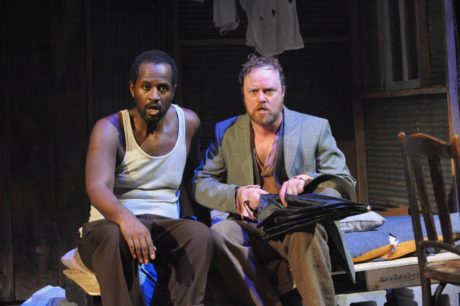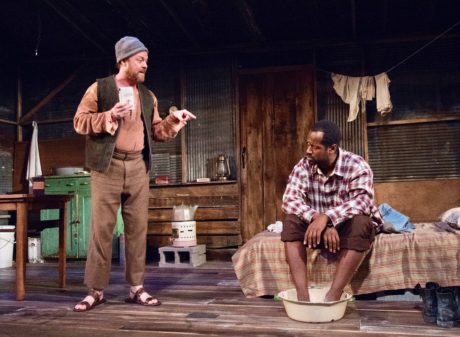South African playwright Athol Fugard’s early masterpiece, Blood Knot, has finally returned to DC. And, judging by the roaring ovation on opening night, those who can see this production during its brief run at Mosaic Theater Company of DC are in for an electrifying experience.

The play, which marks the opening shot in Mosaic’s first venture into repertory, is the first of two performed back-to-back under the banner of South Africa: Then & Now.
Written and first performed in Johannesburg in 1961—when Fugard was 29 years old—Blood Knot is the tale of two half-brothers caught up in the brutal hold of Apartheid. In South Africa, the complete separation of the races(“apart-ness”) was mandated by law from 1948 to 1991.
In the current production, Nathan Hinton and Tom Story star as the brothers who—born of the same mother but separated by the color of their skin—deliver a mesmerizing performance. Theirs is a family divided under a system that fostered hatred and fear.
Hinton, who plays the dark-skinned brother, Zachariah, starts off with an air of comic glee. His childlike grin literally lights up the stage, evoking gusts of laughter, even as he describes an encounter that the audience knows is rape. “WOMAN,” he roars, like a lion bounding toward his prey. It’s a stereotype, straight out of the Apartheid playbook, of the so-called ‘sex-crazed’ savage. Yet Zachariah’s boredom, defeat and bottomless fatigue—beautifully evoked as he falls into bed each evening—are palpable.
Tom Story is equally powerful as his brother’s would-be keeper, the fair-skinned Morris. This alter-ego brother, who lives on hope and faith—who literally washes his brother’s feet and insists on Bible reading each night—is a disciple of sorts. He preaches the value of saving as well as the salvation to be found in the belief in a future that is largely predicated by white culture.
His metamorphosis is as remarkable as Hinton’s. Almost terminally repressed at the beginning—pinching every penny he can of Zack’s pay so that the two of them can buy a small farm and live happily ever after—he evolves into a comic-book dandy once he dons the suit and straw hat of a white man. Like the color of a man’s skin, the clothing transforms him.
The plot is simple. In order to keep Zachariah from squandering his money on women and booze, Morris decides that Zack needs a pen pal—someone to keep his fantasies alive but not threaten their savings—and sends his brother off to buy a newspaper. Zack comes back with a paper, but, being illiterate, fails to notice that the paper is aimed at whites, not blacks.
And so there is an exchange of letters with Ethel, an 18-year-old white woman with a “developed” body (along with a brother, an uncle, and a best friend). Ethel announces a planned visit. Terrified at being discovered, Zack and Morris change places, so that Morris can pose as the white gentleman. Zack buys the proper attire, Morris tries it on. And then the terror begins.
Blood Knot has its allegorical moments, but it’s not simplistic. It’s a metaphor for racial conflict, in that the clothing, like the skin color, is superficial. Yet the superficial dictates the profound. The jacket, hat, boots, and umbrella are cartoonish, but lethal.
So, too, is the ‘blood knot’ of the title. Like people of different races, the brothers are products of the same soil and possess almost the same DNA. They share the same mother—a ghostly figure who wanders, sad and speechless, across the stage and in their dreams—but who, in memory, is two entirely different people.
Played by Anika Harden, the mother is remembered as saintly by Morris and careless by Zack. (Of course, Morris is the one who got the love and the schooling!)
Even the music that resonates throughout the play varies with each of the brother’s memories. Though it’s all the work of one composer, Mongezi Ntaka, the styles are very different. For Morris, the tunes are lullabies, but for Zack they are boozy chants.

The split between the brothers—reflecting the split in society and the family—is a wound that deepens, then explodes. The enormity of the wound is wonderfully amplified by the cacophany of Michael Gianetti’s lighting and David Lamont Wilson’s sound, the two conspiring to create brilliant landscapes of darkness and light, shouting and silence.
Of course, much is done with smoke and mirrors, thanks to Projections Designer Patrick Lord and Technical Director William M. Woodard, whose work brings memories and dreams to life. An opening in the otherwise complete darkness of the sky creates the illusion of hope.
Michelle Elwyn gives us props that speak volumes. There is a clanging alarm clock that rings whenever it’s time to say prayers or eat, a kettle and boxes of epsom salts for washing the laborer’s feet and—most poignant of all—the single boiled egg on each plate that serves as the brothers’ dinner.
Similarly, Costume Designer Brandee Mathies has put together outfits that spell out unspoken details. It’s no coincidence that Morris, the prodigal son who has returned to his roots, wears rags that resemble a hermit’s garb, while Zack, for all his menial labor, sports a bright shirt or two. The “gentleman’s outfit” is a joy to behold, complete with handkerchief and socks.
The fact that both actors sport genuine South African accents—Morris as the ultimate Boer War descendant and Zack as the simple “native”—is the work of Dialect Coach Kim Bey. (One of Hinton’s most extrardinory tricks is the ability to make himself completely understood, even when, at the beginning, the accent is heavy.)
And the fact that the two don’t actually kill each other—despite coming close—is the work of Robb Hunter, the talented Fight Choreographer.
Debra Booth has designed an extraordinary set, consisting of three sides of a corrugated tin shack that radiates poverty and warmth. There is a clothes line hanging from the ceiling, full of underwear and the rags the brothers use for a makeshift bath. Zack’s bed is a matress on cement blocks, while Morris sleeps on a bed roll stretched out on the floor. A single table and chair are supplemented by a wooden crate, standing in for a second seat.
Adapting a 56-year-old play for a modern audience was a daunting task, according to Dramaturg Otis Cortez Ramsey-Zöe. Blood Knot, he says, is an “elusive play, largely because of its blend of realism and allegory.” Ramsey- Zöe, who lectures on theatre at Howard University, describes the bending of time and space as Beckett-like in its deliberate indeterminacy.
Joy Zinoman, known to many DC theater-goers as the founder and longtime director of Studio Theatre, directed this production. She was lured to Mosaic by Serge Seiden, a longtime colleague at Studio and Mosaic’s Co-Founder and Managing Director.
Adding the role of the mother was Zinoman’s idea. “I had a dream of the mother haunting their house,” she explains, adding that as a woman directing a very male play, she wanted to include a female presence. The silent drifting of the mother—in contrast to the noisier comings and goings of Zack—is the work of Stage Manager Solomon HaileSelassie.
Now 84-years-old, playwright Athol Fugard teaches theatre at the University of California at San Diego. Part Afrikaaner himself, Fugard played the role of Morris opposite Zakes Mokae when the play opened in 1961. (It closed the next day, since the laws of Apartheid prohibited actors of different races from appearing on stage together.) The two reprised their roles nearly 24 years later on Broadway.
Blood Knot is the “then” of South Africa: Then & Now. But the “then,” alas, is still with us—in ways too subtle to recognize—and in too many parts of the world. The “now,” depicted by A Human Being Died That Night, opens shortly.
Running Time: Two hours and 10 minutes, with one 15-minute intermission.
Blood Knot plays through April 30, 2017, at Mosaic Theater Company of DC performing at the Atlas Performing Arts Center – 1333 H Street NE, in Washington, DC. For tickets, call the box office at (202) 399-7993 ext. 2, or purchase them online.





